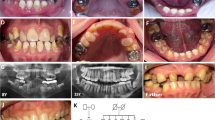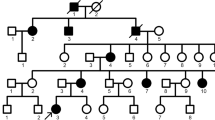Abstract
Objective
Amelogenesis imperfecta (AI) is a rare hereditary disorder affecting the quality and quantity of the tooth enamel. The purpose of this study was to identify the genetic etiology of hypoplastic AI families based on the candidate gene approach.
Materials and methods
We recruited three Turkish families with hypoplastic AI and performed a candidate gene screening based on the characteristic clinical feature to find the pathogenic genetic etiology.
Results
The candidate gene sequencing of the LAMB3 gene for family 1 revealed a heterozygous nonsense mutation in the last exon [c.3431C > A, p.(Ser1144*)]. FAM20A gene sequencing for families 2 and 3 identified a homozygous deletion [c.34_35delCT, p.(Leu12Alafs*67)] and a homozygous deletion-insertion (c.1109 + 3_1109 + 7delinsTGGTC) mutation, respectively.
Conclusion
The candidate gene approach can be successfully used to identify the genetic etiology of the AI in some cases with characteristic clinical features.
Clinical relevance
Identification of the genetic etiology of the AI will help both the family members and dentist understand the nature of the disorder. Characteristic clinical feature can suggest possible genetic causes.




Similar content being viewed by others
References
Thesleff I (2003) Epithelial-mesenchymal signalling regulating tooth morphogenesis. J Cell Sci 116:1647–1648. https://doi.org/10.1242/jcs.00410
Hu JC, Simmer JP (2007) Developmental biology and genetics of dental malformations. Orthod Craniofacial Res 10:45–52. https://doi.org/10.1111/j.1601-6343.2007.00384.x
Witkop CJ Jr (1988) Amelogenesis imperfecta, dentinogenesis imperfecta and dentin dysplasia revisited: problems in classification. J Oral Pathol 17:547–553. https://doi.org/10.1111/j.1600-0714.1988.tb01332.x
Lagerstrom M, Dahl N, Nakahori Y, Nakagome Y, Backman B, Landegren U, Pettersson U (1991) A deletion in the amelogenin gene (AMG) causes X-linked amelogenesis imperfecta (AIH1). Genomics 10:971–975. https://doi.org/10.1016/0888-7543(91)90187-j
Rajpar MH, Harley K, Laing C, Davies RM, Dixon MJ (2001) Mutation of the gene encoding the enamel-specific protein, enamelin, causes autosomal-dominant amelogenesis imperfecta. Hum Mol Genet 10:1673–1677. https://doi.org/10.1093/hmg/10.16.1673
Poulter JA, Murillo G, Brookes SJ, Smith CE, Parry DA, Silva S, Kirkham J, Inglehearn CF, Mighell AJ (2014) Deletion of ameloblastin exon 6 is associated with amelogenesis imperfecta. Hum Mol Genet 23:5317–5324. https://doi.org/10.1093/hmg/ddu247
Kim JW, Lee SK, Lee ZH, Park JC, Lee KE, Lee MH, Park JT, Seo BM, Hu JC, Simmer JP (2008) FAM83H mutations in families with autosomal-dominant hypocalcified amelogenesis imperfecta. Am J Hum Genet 82:489–494. https://doi.org/10.1016/j.ajhg.2007.09.020
McGrath JA, Gatalica B, Li K, Dunnill MG, McMillan JR, Christiano AM, Eady RA, Uitto J (1996) Compound heterozygosity for a dominant glycine substitution and a recessive internal duplication mutation in the type XVII collagen gene results in junctional epidermolysis bullosa and abnormal dentition. Am J Pathol 148:1787–1796
Yuen WY, Pasmooij AM, Stellingsma C, Jonkman MF (2012) Enamel defects in carriers of a novel LAMA3 mutation underlying epidermolysis bullosa. Acta Derm Venereol 92:695–696. https://doi.org/10.2340/00015555-1341
Poulter JA, El-Sayed W, Shore RC, Kirkham J, Inglehearn CF, Mighell AJ (2014) Whole-exome sequencing, without prior linkage, identifies a mutation in LAMB3 as a cause of dominant hypoplastic amelogenesis imperfecta. Eur J Hum Genet 22:132–135. https://doi.org/10.1038/ejhg.2013.76
Hart PS, Hart TC, Michalec MD, Ryu OH, Simmons D, Hong S, Wright JT (2004) Mutation in kallikrein 4 causes autosomal recessive hypomaturation amelogenesis imperfecta. J Med Genet 41:545–549. https://doi.org/10.1136/jmg.2003.017657
Kim JW, Simmer JP, Hart TC, Hart PS, Ramaswami MD, Bartlett JD, Hu JC (2005) MMP-20 mutation in autosomal recessive pigmented hypomaturation amelogenesis imperfecta. J Med Genet 42:271–275. https://doi.org/10.1136/jmg.2004.024505
El-Sayed W, Parry DA, Shore RC, Ahmed M, Jafri H, Rashid Y, Al-Bahlani S, Al Harasi S, Kirkham J, Inglehearn CF, Mighell AJ (2009) Mutations in the beta propeller WDR72 cause autosomal-recessive hypomaturation amelogenesis imperfecta. Am J Hum Genet 85:699–705. https://doi.org/10.1016/j.ajhg.2009.09.014
Parry DA, Poulter JA, Logan CV, Brookes SJ, Jafri H, Ferguson CH, Anwari BM, Rashid Y, Zhao H, Johnson CA, Inglehearn CF, Mighell AJ (2013) Identification of mutations in SLC24A4, encoding a potassium-dependent sodium/calcium exchanger, as a cause of amelogenesis imperfecta. Am J Hum Genet 92:307–312. https://doi.org/10.1016/j.ajhg.2013.01.003
Parry DA, Smith CE, El-Sayed W, Poulter JA, Shore RC, Logan CV, Mogi C, Sato K, Okajima F, Harada A, Zhang H, Koruyucu M, Seymen F, Hu JC, Simmer JP, Ahmed M, Jafri H, Johnson CA, Inglehearn CF, Mighell AJ (2016) Mutations in the pH-sensing G-protein-coupled receptor GPR68 cause amelogenesis imperfecta. Am J Hum Genet 99:984–990. https://doi.org/10.1016/j.ajhg.2016.08.020
Parry DA, Brookes SJ, Logan CV, Poulter JA, El-Sayed W, Al-Bahlani S, Al Harasi S, Sayed J, Raifel M, Shore RC, Dashash M, Barron M, Morgan JE, Carr IM, Taylor GR, Johnson CA, Aldred MJ, Dixon MJ, Wright JT, Kirkham J, Inglehearn CF, Mighell AJ (2012) Mutations in C4orf26, encoding a peptide with in vitro hydroxyapatite crystal nucleation and growth activity, cause amelogenesis imperfecta. Am J Hum Genet 91:565–571. https://doi.org/10.1016/j.ajhg.2012.07.020
Wang SK, Choi M, Richardson AS, Reid BM, Lin BP, Wang SJ, Kim JW, Simmer JP, Hu JC (2014) ITGB6 loss-of-function mutations cause autosomal recessive amelogenesis imperfecta. Hum Mol Genet 23:2157–2163. https://doi.org/10.1093/hmg/ddt611
Poulter JA, Brookes SJ, Shore RC, Smith CE, Abi Farraj L, Kirkham J, Inglehearn CF, Mighell AJ (2014) A missense mutation in ITGB6 causes pitted hypomineralized amelogenesis imperfecta. Hum Mol Genet 23:2189–2197. https://doi.org/10.1093/hmg/ddt616
Seymen F, Kim YJ, Lee YJ, Kang J, Kim TH, Choi H, Koruyucu M, Kasimoglu Y, Tuna EB, Gencay K, Shin TJ, Hyun HK, Kim YJ, Lee SH, Lee ZH, Zhang H, Hu JC, Simmer JP, Cho ES, Kim JW (2016) Recessive mutations in ACPT, encoding testicular acid phosphatase, cause hypoplastic amelogenesis imperfecta. Am J Hum Genet 99:1199–1205. https://doi.org/10.1016/j.ajhg.2016.09.018
O’Sullivan J, Bitu CC, Daly SB, Urquhart JE, Barron MJ, Bhaskar SS, Martelli-Junior H, dos Santos Neto PE, Mansilla MA, Murray JC, Coletta RD, Black GC, Dixon MJ (2011) Whole-exome sequencing identifies FAM20A mutations as a cause of amelogenesis imperfecta and gingival hyperplasia syndrome. Am J Hum Genet 88:616–620. https://doi.org/10.1016/j.ajhg.2011.04.005
Wang SK, Aref P, Hu Y, Milkovich RN, Simmer JP, El-Khateeb M, Daggag H, Baqain ZH, Hu JC (2013) FAM20A mutations can cause enamel-renal syndrome (ERS). PLoS Genet 9:e1003302. https://doi.org/10.1371/journal.pgen.1003302
Parry DA, Mighell AJ, El-Sayed W, Shore RC, Jalili IK, Dollfus H, Bloch-Zupan A, Carlos R, Carr IM, Downey LM, Blain KM, Mansfield DC, Shahrabi M, Heidari M, Aref P, Abbasi M, Michaelides M, Moore AT, Kirkham J, Inglehearn CF (2009) Mutations in CNNM4 cause Jalili syndrome, consisting of autosomal-recessive cone-rod dystrophy and amelogenesis imperfecta. Am J Hum Genet 84:266–273. https://doi.org/10.1016/j.ajhg.2009.01.009
Kim JW, Seymen F, Lee KE, Ko J, Yildirim M, Tuna EB, Gencay K, Shin TJ, Kyun HK, Simmer JP, Hu JC (2013) LAMB3 mutations causing autosomal-dominant amelogenesis imperfecta. J Dent Res 92:899–904. https://doi.org/10.1177/0022034513502054
Cho SH, Seymen F, Lee KE, Lee SK, Kweon YS, Kim KJ, Jung SE, Song SJ, Yildirim M, Bayram M, Tuna EB, Gencay K, Kim JW (2012) Novel FAM20A mutations in hypoplastic amelogenesis imperfecta. Hum Mutat 33:91–94. https://doi.org/10.1002/humu.21621
Beck K, Hunter I, Engel J (1990) Structure and function of laminin: anatomy of a multidomain glycoprotein. FASEB J 4:148–160. https://doi.org/10.1096/fasebj.4.2.2404817
Masunaga T (2006) Epidermal basement membrane: its molecular organization and blistering disorders. Connect Tissue Res 47:55–66. https://doi.org/10.1080/03008200600584157
Lee KE, Ko J, Le CG, Shin TJ, Hyun HK, Lee SH, Kim JW (2015) Novel LAMB3 mutations cause non-syndromic amelogenesis imperfecta with variable expressivity. Clin Genet 87:90–92. https://doi.org/10.1111/cge.12340
Wang X, Zhao Y, Yang Y, Qin M (2015) Novel ENAM and LAMB3 mutations in Chinese families with hypoplastic amelogenesis imperfecta. PLoS One 10:e0116514. https://doi.org/10.1371/journal.pone.0116514
Kim YJ, Shin TJ, Hyun HK, Lee SH, Lee ZH, Kim JW (2016) A novel de novo mutation in LAMB3 causes localized hypoplastic enamel in the molar region. Eur J Oral Sci 124:403–405. https://doi.org/10.1111/eos.12280
Cui J, Xiao J, Tagliabracci VS, Wen J, Rahdar M, Dixon JE (2015) A secretory kinase complex regulates extracellular protein phosphorylation. eLife 4:e06120. https://doi.org/10.7554/eLife.06120
Cui J, Zhu Q, Zhang H, Cianfrocco MA, Leschziner AE, Dixon JE, Xiao J (2017) Structure of Fam20A reveals a pseudokinase featuring a unique disulfide pattern and inverted ATP-binding. eLife 6:e23990. https://doi.org/10.7554/eLife.23990
Jaureguiberry G, De la Dure-Molla M, Parry D, Quentric M, Himmerkus N, Koike T, Poulter J, Klootwijk E, Robinette SL, Howie AJ, Patel V, Figueres ML, Stanescu HC, Issler N, Nicholson JK, Bockenhauer D, Laing C, Walsh SB, McCredie DA, Povey S, Asselin A, Picard A, Coulomb A, Medlar AJ, Bailleul-Forestier I, Verloes A, Le Caignec C, Roussey G, Guiol J, Isidor B, Logan C, Shore R, Johnson C, Inglehearn C, Al-Bahlani S, Schmittbuhl M, Clauss F, Huckert M, Laugel V, Ginglinger E, Pajarola S, Sparta G, Bartholdi D, Rauch A, Addor MC, Yamaguti PM, Safatle HP, Acevedo AC, Martelli-Junior H, dos Santos Netos PE, Coletta RD, Gruessel S, Sandmann C, Ruehmann D, Langman CB, Scheinman SJ, Ozdemir-Ozenen D, Hart TC, Hart PS, Neugebauer U, Schlatter E, Houillier P, Gahl WA, Vikkula M, Bloch-Zupan A, Bleich M, Kitagawa H, Unwin RJ, Mighell A, Berdal A, Kleta R (2012) Nephrocalcinosis (enamel renal syndrome) caused by autosomal recessive FAM20A mutations. Nephron Physiol 122:1–6. https://doi.org/10.1159/000349989
Vogel P, Hansen GM, Read RW, Vance RB, Thiel M, Liu J, Wronski TJ, Smith DD, Jeter-Jones S, Brommage R (2012) Amelogenesis imperfecta and other biomineralization defects in Fam20a and Fam20c null mice. Vet Pathol 49:998–1017. https://doi.org/10.1177/0300985812453177
Kantaputra PN, Bongkochwilawan C, Kaewgahya M, Ohazama A, Kayserili H, Erdem AP, Aktoren O, Guven Y (2014) Enamel-renal-gingival syndrome, hypodontia, and a novel FAM20A mutation. Am J Med Genet A 164a:2124–2128. https://doi.org/10.1002/ajmg.a.36579
Kim JW, Simmer JP, Hu YY, Lin BP, Boyd C, Wright JT, Yamada CJ, Rayes SK, Feigal RJ, Hu JC (2004) Amelogenin p.M1T and p.W4S mutations underlying hypoplastic X-linked amelogenesis imperfecta. J Dent Res 83:378–383. https://doi.org/10.1177/154405910408300505
Kang HY, Seymen F, Lee SK, Yildirim M, Tuna EB, Patir A, Lee KE, Kim JW (2009) Candidate gene strategy reveals ENAM mutations. J Dent Res 88:266–269. https://doi.org/10.1177/0022034509333180
Acknowledgements
We thank the participants in this study for their cooperation.
Funding
This work was supported by grants by the National Research Foundation of Korea (NRF) grant funded by the Korea government (NRF-2017R1A2A2A05069281) and NIDCR/NIH grant DE015846.
Author information
Authors and Affiliations
Corresponding author
Ethics declarations
Conflict of interest
The authors declare that they have no conflict of interest.
Ethical approval
All procedures performed in studies involving human participants were in accordance with the ethical standards of the institutional and/or national research committee and with the 1964 Helsinki declaration and its later amendments or comparable ethical standards.
Informed consent
Informed consent was obtained from all individual participants included in the study. The study protocol was reviewed and approved by the Institutional Review Board at Seoul National University Dental Hospital (CRI05003G) and at the University of Istanbul (IRB00009905).
Electronic supplementary material
ESM 1
(DOCX 940 kb)
Rights and permissions
About this article
Cite this article
Kim, Y.J., Seymen, F., Kang, J. et al. Candidate gene sequencing reveals mutations causing hypoplastic amelogenesis imperfecta. Clin Oral Invest 23, 1481–1487 (2019). https://doi.org/10.1007/s00784-018-2577-9
Received:
Accepted:
Published:
Issue Date:
DOI: https://doi.org/10.1007/s00784-018-2577-9




